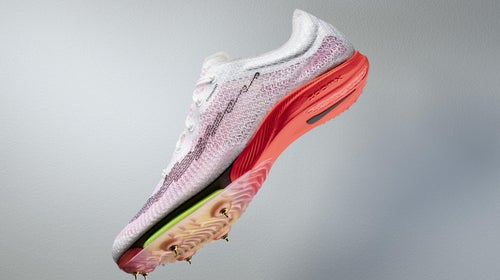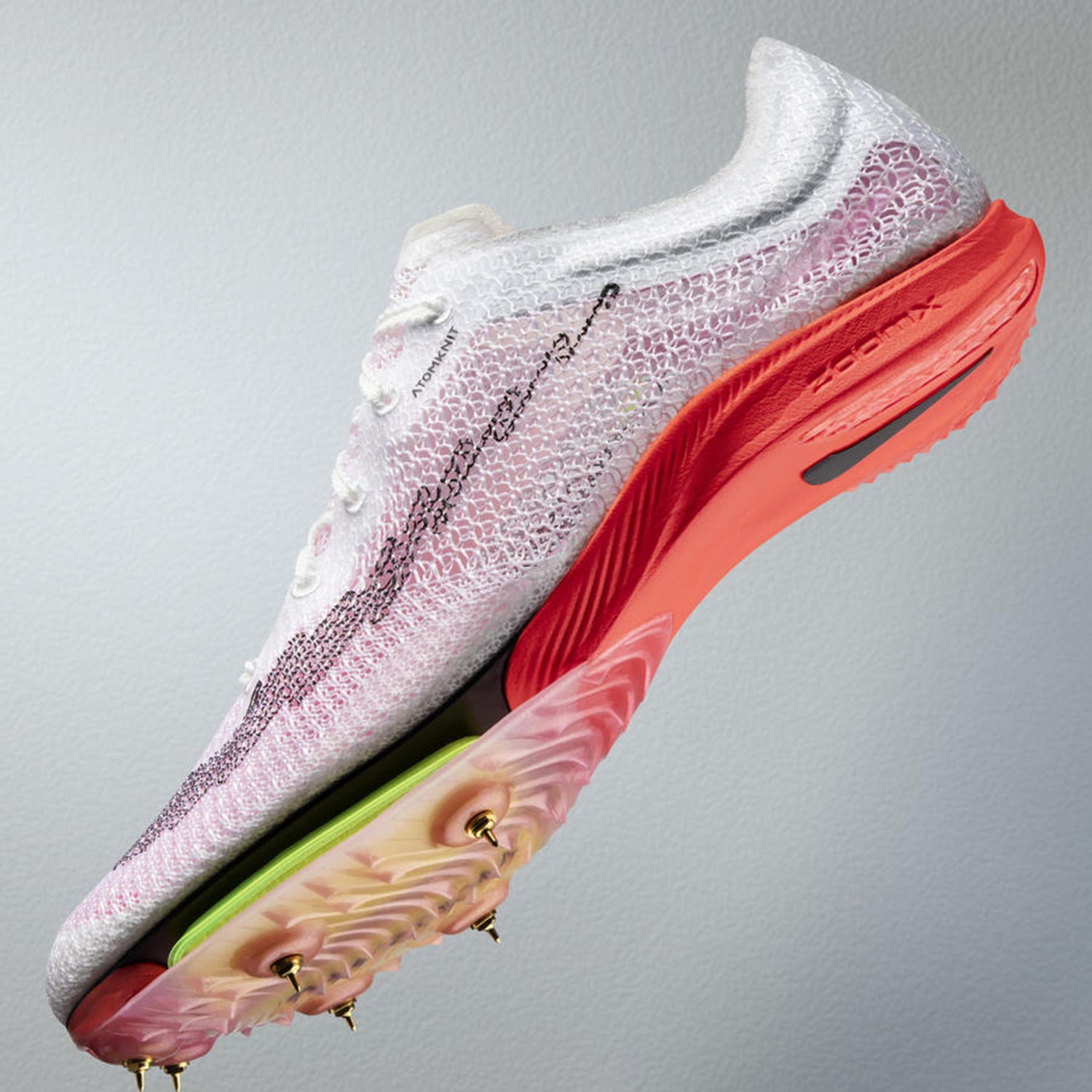The 2016 Olympics were the Vaporfly Games, even though no one knew it at the time. The top three finishers in the men’s marathon and the winner of the women’s marathon were all wearing disguised Nike prototypes with thick soles and curved carbon-fiber plates, of the type that would later be revealed to offer a four percent efficiency boost compared to the best road-racing shoes of the time. For the next few years, shoe technology was pretty much the only thing runners talked about.
Now for the sequel. In Tokyo, it’ll be all about track spikes. Sure, the marathoners will be wearing new-generation shoes, but that technology is now well-known and available from a wide variety of shoe brands. It may not be a perfectly level playing field, but it never is. On the track, in contrast, a new generation of super spikes, loosely modeled on the foam-and-carbon-plate marathon shoes, is upending the record books—but so far no one is entirely sure how they work, how much time they save, and whether rival shoe companies can match Nike’s head start.
While the original Vaporfly was marketed based on its backed-by-science performance advantage, the new super spikes haven’t been accompanied by any specific claims of how fast they are. In fact, because of the physiological differences between middle-distance running and marathoning, it’s not even clear how you’d test that. But (meaning an academic paper that hasn’t yet been through peer review), from a group at the University of Massachusetts Amherst led by Wouter Hoogkamer and Laura Healey, takes a first stab at explaining how the super spikes might work and what the key components are.
The Anecdotal Data
It was Hoogkamer, along with his colleagues in Rodger Kram’s research group at the University of Colorado, who performed the original study showing that Nike’s Vaporfly was four percent more efficient than rival shoes. But the tests he used for the Vaporfly only work at relatively slow running speeds—so for the track spikes, all we have is the vague sense that people are running really fast. Since prototypes first started to show up in 2019, the men’s and women’s 5,000- and 10,000-meter world records have all been smashed. Same with the women’s mile and indoor 1,500, and the men’s indoor mile and 1,500. have fallen. High school records have fallen. Something is going on.
There are alternate explanations. Most notably, Wavelight pacing technology has added metronome-like consistency to record attempts, and the pandemic has enforced long periods of uninterrupted training. But most observers are confident that the new spikes are providing meaningful time savings. It’s hard to imagine if they weren’t convinced of a real effect.
The Active Ingredients
Super spikes, by Hoogkamer’s definition, “combine lightweight, compliant, resilient foams (and air pods) with a stiff (nylon/PEBA/carbon-fiber) plate.” Those two ingredients—foam and plate—are also the salient features of the Vaporfly and comparable marathon shoes, but there are some differences. Road shoe soles, according to the current World Athletics rules, can be up to 40 millimeters thick; track spikes for 800 meters and up can only be 25 millimeters thick. Spikes also have, well, spikes on the bottom, designed to grip the rubbery surface of the track.
When the original Vaporfly was introduced, most of the attention focused on the curved carbon fiber plate, which people assumed would function as a “spring.” But subsequent research has mostly debunked that notion. In fact, by Healey and Hoogkamer tested runners in regular Vaporflys and in Vaporflys with six parallel cuts through the carbon plate to eliminate any connection between the rearfoot and forefoot. Surprisingly, running economy was essentially unaffected by cutting the plate. The plate probably does something, but the simple picture of a spring-loaded shoe doesn’t seem to explain its performance.
Biomechanics researchers have been studying carbon fiber plates for several decades, and they tend to view the plates as levers or stiffening devices, rather than springs. There’s pretty good evidence that, under the right conditions, a stiff plate saves a bit of energy that you’d otherwise waste in bending your big toe. But various lines of evidence, including the sawed-up Vaporflys and the fact that spikes have always had a rigid spike plate, suggest that the stiff plate itself isn’t the secret sauce that makes super shoes so good.
Instead, the most obvious change between old and new spikes is the addition of a layer of cushioning foam. The new foams, which include materials like PEBA (polyether block amide), TPU (thermoplastic polyurethane), and various other bespoke blends, are different from traditional midsole materials in three key ways: they’re lighter, more compressible, and more resilient (meaning they spring back after being compressed, returning much of the energy you used to compress them). Old shoes did all the same things; the new shoes just do them better. Traditional EVA midsoles returned less than 70 percent of the energy input, whereas the best new foams give back more than 85 percent. And it’s 85 percent of a bigger number, because you can have a thicker layer of foam that stores more energy without weighing the shoe down.
A more subtle difference in the super spikes is the geometry. In addition to a thicker heel, they have a very pronounced rocker, or upturned toe. Last year University of Calgary researcher Benno Nigg proposed that the Vaporfly’s performance was the result of a “,” in which stepping on the curved toe of the carbon plate catapulted the heel off the ground. Once again, the sawed-up Vaporflys argue against this particular theory—but it’s notable that no one has managed to build a super shoe without some sort of curved plate, so the geometry is likely important for reasons that aren’t clear.
The Scientific Evidence
Okay, so we’ve got lots of theories. Why not test them? One problem, Hoogkamer and his co-authors point out, is that there isn’t a mass market for track spikes like there is for road shoes. It makes sense to optimize the general parameters of a shoe if you’re going to sell tens of thousands of them. For a niche product like spikes, shoe companies are more interested in tailoring the parameters to the individual needs of their star athletes.
But there’s also a more basic problem. The road shoes were tested based on running economy, which is a measure of how much energy you consume to run at a given speed. You can estimate energy consumption by measuring the amount of oxygen and carbon dioxide a runner breathes in and out—but that estimate only works if you’re running aerobically (i.e. below threshold). Once you start running faster, you rely more and more on anaerobic energy, and the breathing-based calculations become meaningless. Track spikes are designed for fast running, so a test that involved jogging at marathon pace in middle-distance spikes wouldn’t tell you much.
At the other end of the spectrum, you can test sprint spikes by having people sprint all-out in different models and timing them. But the new super spikes are designed for a tricky middle ground, attempting to optimize metabolic efficiency while running at not-quite-sprinting speeds. There simply isn’t a good test for that. The best option is probably a series of time trials at relevant race distances, but that’s a very slow and painful way of collecting data. There’s also the potential for big-data approaches like in 2018. But there’s a lot less data available for track races, and the elite rankings for 2020 and 2021 have been seriously skewed (whether for better or worse isn’t clear) by the pandemic. It may be a while before we can make any meaningful estimates of how fast the new spikes are, let alone how different models compare.
The Playing Field
So far, Nike’s two super spike models have dominated the conversation: the Air Zoom Victory, with a carbon-fiber plate and PEBA foam; and the ZoomX Dragonfly, with a PEBA plate and PEBA foam. They’ve been the shoe behind most of the new records and notable performances, though it’s hard to know how much of that is simply because Nike sponsors the most elite athletes. New Balance’s FuelCell MD-X, with a carbon-fiber plate and TPU foam, has also turned heads since it first showed up at the 2019 World Championships, perhaps most notably when Elle Purrier, Cory McGee, and Heather MacLean at the U.S. Olympic Trials last month.
Other companies like Adidas, Asics, Brooks, Hoka, Saucony, and Puma all have comparable models either on the market or in prototypes. It’s pretty hard to keep track of who’s wearing which shoe and which ones are actually on the market, much less which ones actually work as advertised. That means shoes will be an inevitable subtext while we watch the races in Tokyo: we’ll be peering at the screen, wondering “What was the guy in fourth wearing? Should he have been on the podium?” (I’ll confess that my very first reaction after watching Ryan Crouser throw a new shot put world record during the Olympic Trials was “Oh wow, have they developed super shoes for throwers too?”)
Still, it could have been worse. If the Olympics had taken place last summer, as scheduled, the playing field would have been dramatically tilted, almost like a repeat of 2016 but affecting way more events. The year of delay has eased the supply crunch (though it’s still a challenge for the average person to get their hands on a pair) and allowed most other companies to get in the game. Those that haven’t yet caught up are generally letting their athletes run in rivals’ shoes. I suspect we won’t see many distance runners in the finals who don’t have a plate and a layer of foam under their soles. So enjoy the action, the tactical battles, and the head-to-head competition… and maybe don’t pay too much attention to the clock.
For more Sweat Science, join me on and , sign up for the , and check out my book .


